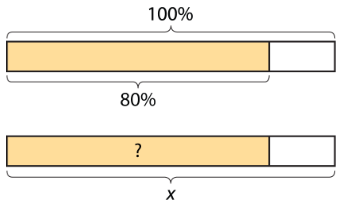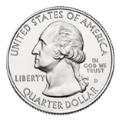18.5: Finding This Percent of That
( \newcommand{\kernel}{\mathrm{null}\,}\)
Lesson
Let's solve percentage problems like a pro.
Exercise 18.5.1: Number Talk: Decimals
Find the value of each expression mentally.
(0.23)⋅100
50÷100
145⋅1100
7÷100
Exercise 18.5.2: Audience Size
A school held several evening activities last month—a music concert, a basketball game, a drama play, and literacy night. The music concert was attended by 250 people. How many people came to each of the other activities?
- Attendance at a basketball game was 30% of attendance at the concert.
- Attendance at the drama play was 140% of attendance at the concert.
- Attendance at literacy night was 44% of attendance at the concert.
Are you ready for more?
50% of the people who attended the drama play also attended the music concert. What percentage of the people who attended the music concert also attended the drama play?
Exercise 18.5.3: Everything is On Sale
During a sale, every item in a store is 80% of its regular price.
- If the regular price of a T-shirt is $10, what is its sale price?
- The regular prices of five items are shown here. Find the sale price of each item.
item 1 item 2 item 3 item 4 item 5 regular price $1 $4 $10 $55 $120 sale price Table 18.5.1 - You found 80% of many values. Was there a process you repeated over and over to find the sale prices? If so, describe it.

- Select all of the expressions that could be used to find 80% of x. Be prepared to explain your reasoning.
8100⋅x810⋅x85⋅x80⋅x(0.8)⋅x80100⋅x410⋅x45⋅x8⋅x(0.08)⋅x
Summary
To find 49% of a number, we can multiply the number by 49100 or 0.49.

To find 135% of a number, we can multiply the number by 135100 or 1.35.
To find 6% of a number, we can multiply the number by 6100 or 0.06.

In general, to find P% of x, we can multiply: P100⋅x
Glossary Entries
Definition: Percent
The word percent means “for each 100.” The symbol for percent is %.
For example, a quarter is worth 25 cents, and a dollar is worth 100 cents. We can say that a quarter is worth 25% of a dollar.


Definition: Percentage
A percentage is a rate per 100.
For example, a fish tank can hold 36 liters. Right now there is 27 liters of water in the tank. The percentage of the tank that is full is 75%.

Practice
Exercise 18.5.4
- To find 40% of 75, Priya calculates . Does her calculation give the correct value for 40% of 75? Explain or show how you know.
- If represents a number, does always represent 40% of that number? Explain your reasoning.
Exercise 18.5.5
Han spent 75 minutes practicing the piano over the weekend. For each question, explain or show your reasoning.
- Priya practiced the violin for 152% as much time as Han practiced the piano. How long did she practice?
- Tyler practiced the clarinet for 64% as much time as Han practiced the piano. How long did he practice?
Exercise 18.5.6
Last Sunday 1,575 people visited the amusement park. 56% of the visitors were adults, 16% were teenagers, and 28% were children ages 12 and under. Find the number of adults, teenagers, and children that visited the park.
Exercise 18.5.7
Order from greatest to least:
- 55% of 180
- 300% of 26
- 12% of 700
Exercise 18.5.8
Complete each statement.
- 20% of 60 is ________
- 25% of ________ is 6
- ________% of 100 is 14
- 50% of 90 is ________
- 10% of ________ is 7
- 30% of 70 is ________
(From Unit 3.4.5)
Exercise 18.5.9
A shopper needs 24 sandwich rolls. The store sells identical rolls in 2 differently sized packages. They sell a six-pack for $5.28 and a four-pack for $3.40. Should the shopper buy 4 six-packs or 6 four-packs? Explain your reasoning.
(From Unit 3.3.5)
Exercise 18.5.10
On a field trip, there are 3 chaperones for every 20 students. There are 92 people on the trip. Answer these questions. If you get stuck, consider using a tape diagram.
- How many chaperones are there?
- How many children are there?
(From Unit 2.5.1)

